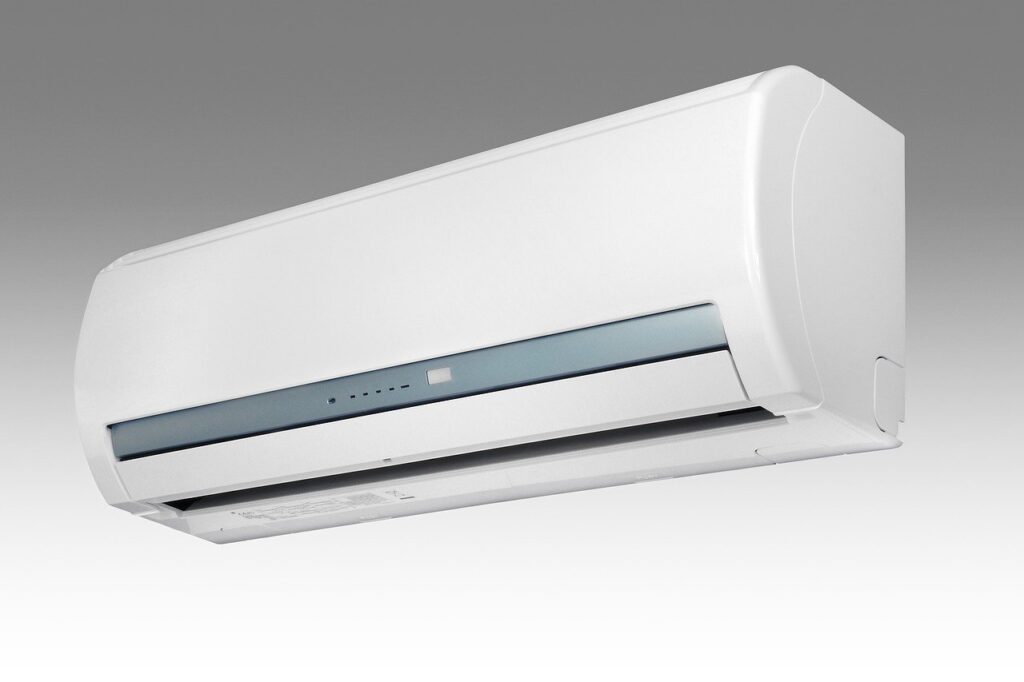
Split AC vs Window AC is a battle that rages in the mind of any person who is on the market for a new air conditioner. It’s an even battle too which means that there’s no clear winner.
So, which AC is best, split or window? The real answer is that it depends. However, to be able to decide between the two, let’s refresh your knowledge of what they are.
Split AC vs Window AC: Definitions and Descriptions
The main difference between window air conditioning and split air conditioning is one of structure design.
The window-type air conditioners are those where all the parts of the air conditioner: the evaporator coils, the compressor, the condenser coils, and the expansion valve are contained within one unit. It is typically in the shape of a box.
On the other hand, a split type air conditioner as compared to a window air conditioner has two units: the outdoor and the indoor unit.
The cool parts of the air conditioner i.e., the evaporator coils and the filter are housed inside the indoor unit while the warm parts like the compressor, the condenser coils, and the venting fan are placed on the outdoor unit.
These differences in the design translate to some major differences in the functionality of the air conditioners in the long term. Here are the factors to consider when making your choice:
Window AC vs Split AC #1: Power Consumption


Air conditioners are expensive and running them is also a considerable spend. Most people know this already, though.
What they get wrong is when they think that split ACs are inherently more energy-efficient than window ACs. While they are in the majority of cases, this isn’t always true. So, when it comes to power consumption which is best? Window AC or split AC?
Here’s the whole story.
The power consumption of an air conditioner depends on a lot of factors. It is quantified as an EER rating. EER stands for Energy Efficiency Rating and the higher the rating the more energy efficient your AC is going to be. Nowadays, you can find both split and window ACs with high EER ratings.
While most split ACs do turn out to be more energy-efficient, it is an oversimplification to think that all split ACs are more energy-efficient than window-type ACs.
In fact, you may even find that a newer window-type AC model turns out to be more efficient than a slightly older split AC model. The rating has to be considered.
However, all other things like tonnage (calculating AC tonnage is not all that difficult) and energy ratings being the same, the best split ACs in the Indian market will always offer more benefits than the best window ACs for home in India.
Even so, if your needs demand that you go for a window-type AC, then don’t hold back simply because you may have to pay more for power. Just opt for a model with a higher EER rating.
Other factors should play into how you make your decision though. Let’s see the next one
Window or Split AC #2: Installation
This one is critical if you’re about to purchase a new AC and are trying to decide which is better window AC or split AC.
Installation in a window-type AC is pretty straightforward and does not need an expert hand. You can get it installed in any adequately sized window pretty conveniently.
Installation of the Split AC, on the other hand, requires some prior thought. Even though the indoor unit can be installed anywhere, you do need more space for mounting the outdoor unit and they do have to be somewhat close to each other, or you will be paying for the extra cost of coils and tubing.
Another factor to consider is the water outlet. In a split type AC, the water outlet pipe has to be given proper way. Not just that, if your internal unit is not mounted in the right manner by expert hands, the water can end up collecting in the unit and even dripping on your walls and wallpaper.
In a window AC the water usually exits out the back but you do end up losing a source of natural light for your space. Also, there is an additional safety concern.
A window-type AC can be removed quite conveniently on the ground level and this might compromise the safety of your home. On the other hand, with the split AC, you do have to consider the safety of your outer unit, since it is usually located on the outside periphery, it is prone to damage.
Window AC or Split AC #3: Maintenance


Another difference between a window AC and a split AC has to do with maintenance costs and difficulties. Since the window-type AC can be accessed easily, its maintenance is simple and relatively cheaper than the split ACs.
With the split AC, you’ll have to maintain two parts – the outer unit and the inner unit. While the outer unit does not present much of a challenge, it’s the inner unit that needs experts.
For instance, the first challenge is that the inner unit has to be serviced while it is mounted on the wall. Then, the next challenge is deep cleaning the fan blades and evaporator coils.
Doing this type of cleaning means that your walls, false ceiling, or wallpaper face the danger of getting soiled and stained. Avoiding this is pretty difficult too. Even trained technicians using specially designed high-power jet sprays and uniquely designed catch-cloths find it difficult to prevent dirty water from running down the walls.
It takes a lot of skill to avoid this which means that you may end up paying more for the technicians’ expertise. Moreover, you might have to move some furniture.
That’s why it’s always best to know and plan in advance where your split AC will be mounted and how it will be serviced.
Split AC or Window AC #4: Noise
The window-type AC tends to be a lot noisier than the split AC. This is because the unit houses the compressor as well, which happens to be the noisiest part of the AC.
In the split AC, the compressor is located in the outer unit. This means that there is minimal noise production in the inner unit, in most cases under 50 decibels.
This makes the split AC a good choice for kid’s rooms and offices and study spaces.
Split AC, of course, is also more aesthetically pleasing. This makes it the winner when it comes to the split AC vs window AC battle for living rooms and dining halls.
Split AC Versus Window AC#5: Cooling Capacity


Cooling a space depends on a lot of factors.
The tonnage of the AC matters most obviously, but other variables like how well the room is sealed, the presence of direct sunlight, and even the room shape matter too.
Between split and window ACs, it’s important to know that there are not any models above 2 tonnes in window ACs, whereas you do get options for a higher tonnage in split AC models.
So, if your space needs an AC of more than 2 tonnes, you’ll automatically be limited to split ACs. Split ACs do generally perform better when just looking at the cooling as the inner unit is mounted higher up on the wall and cold air sinks to the bottom. This creates a cool air current in the room which cools the whole room.
With the window-type ACs, the cold wind is thrown directly at you, which can be bothersome sometimes. In contrast, split ACs cool the entire space and you don’t have to deal with direct chilly air directly.
There is also the issue of cold and warm air pockets in the same room with window ACs, which is mitigated with a split AC.
Split ACs also have the separation of the cold and warm components of the AC which further enhances the efficiency. Due to this reason, split ACs perform better in larger and non-uniform spaces. They also come in a cassette design which can be mounted on the ceiling for multi-directional airflow.
Another split-type option is the multi-split air conditioners. These devices have two separate indoor units with just one outdoor unit. This can be super-efficient in terms of cooling multiple rooms and space management.
Window ACs on the other hand do best when it is a well-sealed clearly defined space with the AC not facing direct sunlight.
Split vs Window AC #6: Price
Price is a major difference between window air conditioning and split air conditioning.
When looking at the initial cost of the AC, installation costs, and maintenance charges, it may be fair to say that split ACs tend to be more expensive than window ACs.
However, what you pay for running the AC on a day-to-day basis is where the real spending is. If your space is not well sealed, both types of ACs can end up costing you more in running charges.
How an AC performs in the long run has a lot to do with how well suited for the space it is. A window AC with a good EER rating can be just as effective as a split AC if it is adequately sized for the space.
If you are really constrained on the budget, then window AC with a 5-star energy rating may be your best bet. However, the split-type AC is not only the safer and more aesthetic bet in most scenarios but also the best when it comes to cooling efficiency.
Contents



